Focusing on quality content rather than churning out blog post after blog post appears to be agreed upon by most, yet when it comes to action, a different story often emerges. SEOs still receive requests to, “find a keyword that we can create a blog for” and slightly more evolved, “tell me how many blogs it will take to rank for this one keyword.”
Instead of following these requests it’s time we explore the needs of our clients and develop the strategies that will deliver on them. To do this, I’ll share five methods I’ve used with clients to move from a keyword based approach to a topic and intent strategy.
1. Using the 80/20 Rule for Content Performance
The first step I use to move away from a keyword driven content plan is to let history do some of the talking. I relate that content performance is subject to the Pareto Principle (aka 80/20 Rule) much as the same as many other factors in our lives- such as 80% of my favorite SNL skits are from 20% of SNL’s cast or 80% of my texts are to 20% of my contacts. So as the performance of our content goes, you can expect that 80% of traffic is going to go to only 20% of content (or less). This isn’t new though.
In 2014 Walter Chen shared an example of this in his post, “ Content Marketing Power Law” and I find it exemplified in nearly all the sites I review. Take the 3 examples below which are from content audits completed for Greenlane clients. These examples took out the homepage of the sites, as homepage typically get a majority of traffic anyway which would have shown more traffic going to even fewer pages.
Percent of Organic sessions to percent of pages of content:
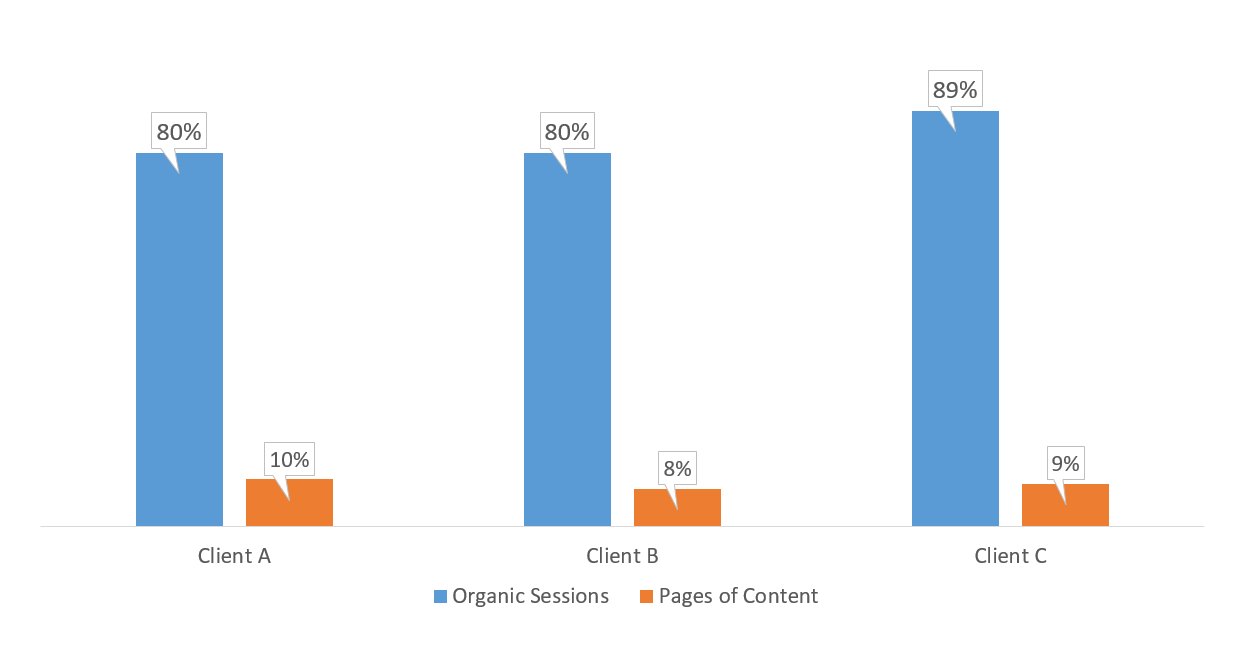
As seen, not even 20% of content is getting the 80% of organic traffic for these sites. In fact, quite a few of the pages didn’t even register a session for the entire year.
Sometimes moving away from (or avoiding) a keyword based content plan is as easy as showing clients these examples. Other times they want to know how their own content is stacking up, so we take a look at that for them. (If you’re curious too, there’s a handy tool over on the Greenlane blog to help you do that.)
2. Use the Power of Google
Now that we covered the history, fast forward to 2016. Developments by Google from the Panda update in 2011 to the rollout of Hummingbird and RankBrain, Google is showing us that content is more than keywords. While the SEO industry is tuned in to each and every Google algorithm change and update announced (and even those that aren’t, hello Possum?!) framing these into meaningful information for a client is something different.
First I start by quoting Google’s itself. Take this quote from Google’s own playbook:
“The key to creating a great website is to create the best possible experience for your audience with original and high quality content.”
— Google’s Search Console Course Section 1.4
Then, I usually follow this up with an example of how keywords don’t need to be the focus of the content for a page to rank well, with an example. Case in point, let’s review the top five results for the search “plan trip with infant.” First to note, 2 of the 3 didn’t include “infant” in the page content at all (noted by the number to the left of the SERP result) yet those in position 4 and 5 have “infant” in the text over 18 and 10 times respectively.
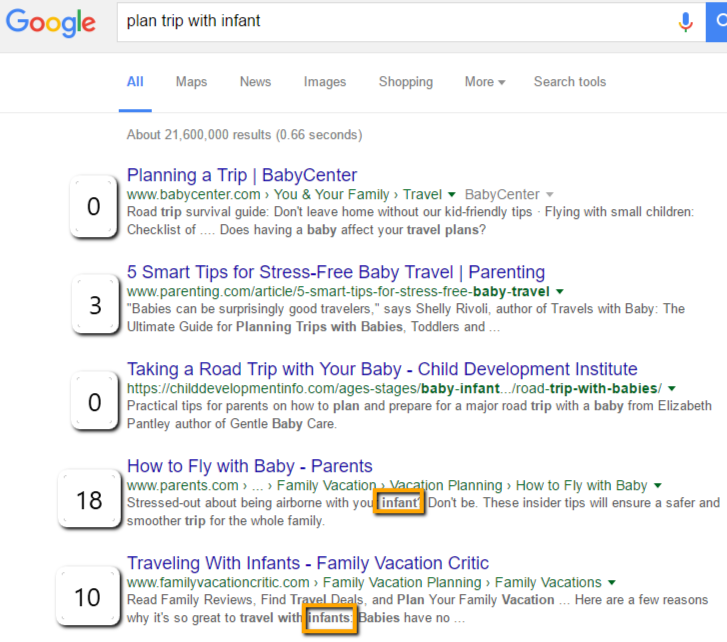
Examples like this aren’t difficult to come by. It’s quite common to see pages your targeting outranked by pages that appear to be “less optimized.” These results used to be shown to clients as example of opportunity. Yet I think we can all agree, Google’s updates, quotes and search results give us the power to say that a specific keyword does not need to be in the copy for a page to rank for it.
3. New Ways to Identify Content Opportunities
How do you find new content for a client who already has half a million pieces of content?
That’s exactly the challenge our team faced for a client, who by the way, was doing pretty well in organic search for this content. So we knew that if content was created, we could get organic traffic to it. But what to create? To answer this, we knew that a keyword by keyword based approach would slow us down in creating pieces of content that could rank for a variety of searches. We wanted to find topics to write about that would be interesting to visitors too.
So we took a step back. All of the websites that I’ve had the pleasure of working on have had competition and this site was no different. Maybe they’re doing better than their competition overall, but what are the weaknesses we can exploit?
Luckily, there’s an easy to use tool out there that in less than a minute, can lead us to that answer - cue SEMrush’s Domain vs Domain (actual title). This tool will show (diagram) and tell (charts) you what keywords your competition is outranking you on. Simple as adding your competitor site and your site into the fields and viewing the results. See below for an example of all the two steps.
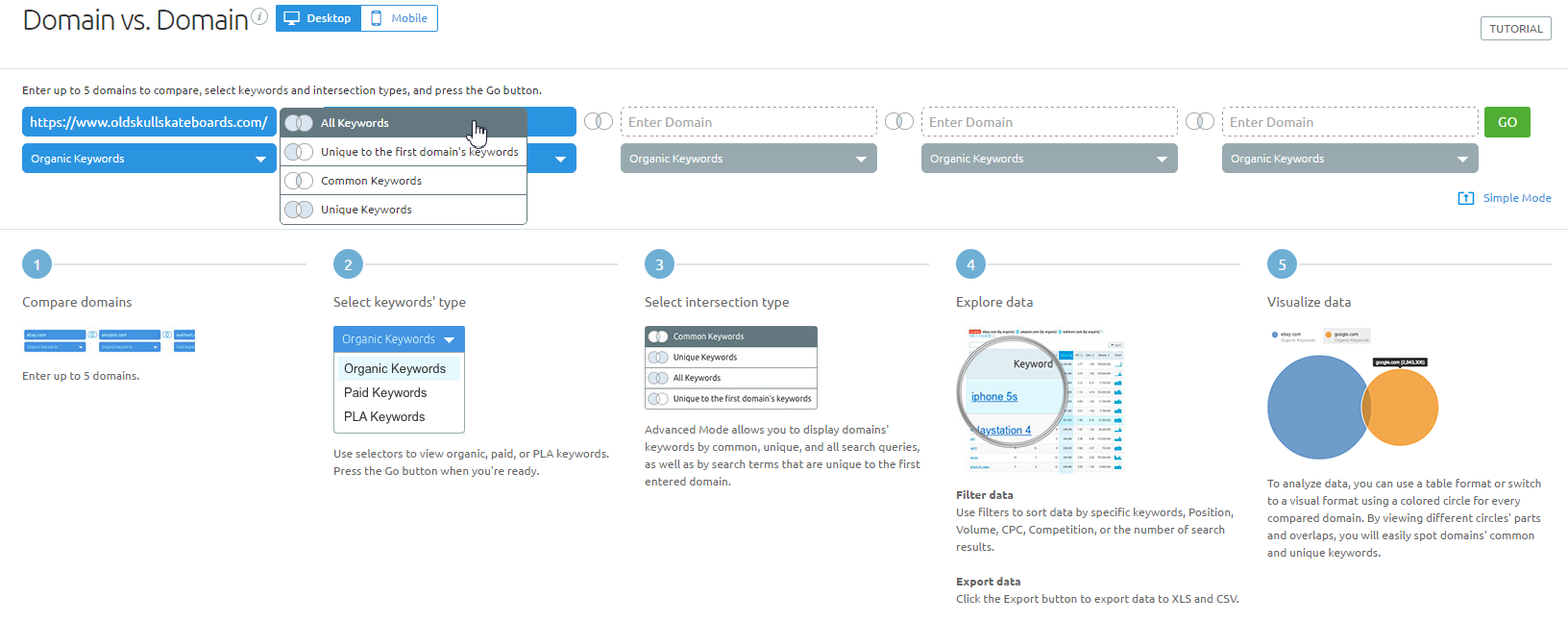
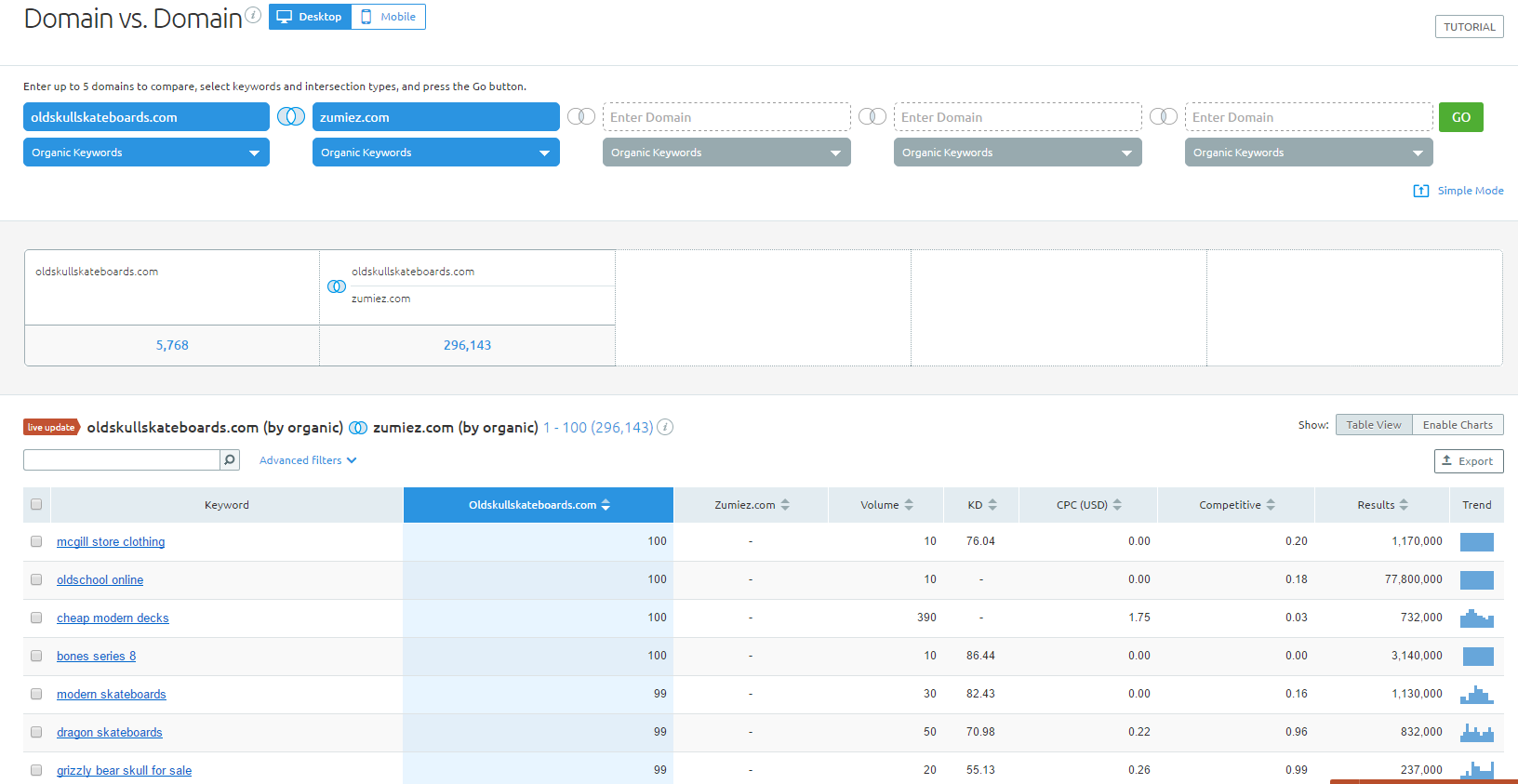
So wait?! I thought we were talking about topics? Of course we are. Again, for our client (not the example above) we needed to give them topics actually write about (aka what the blog post title should actually be) and not just a keyword to include in the post. So we had to take it a step further.
Using a bit of excel wizardry, we filtered and sorted until we discovered topics which keywords could be grouped into. Then we eliminated everything that our competition was going to be better at addressing and then we honed in on the goods.
We found 4 topics representing over 600 keywords and 581,000 monthly searches in total. Do we anticipate to rank for all that search volume? No. Our goal was to find new topics that our client could write about and receive organic traffic for. It worked so well Greenlane’s own Sean Malseed has created a tool that I’ll be sharing in an upcoming webinar, hosted by SEMrush.
Sneak peak!
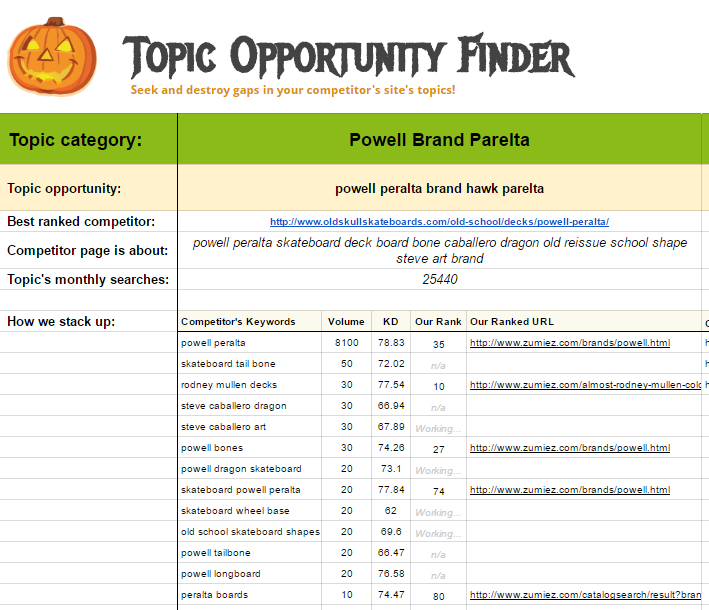
4. Glimpse into Search Intent
What do you say when a prospective client estimates they’ve lost over $500,000 in a year because in the drop in rankings of one keyword (still on page one)?
You figure out how to get them ranking up at the top, real fast. How did we get this mission accomplished? We figured out what the competitive difference was between the sites ranking above us and took every measure our site would allow to surpass them. We did also tackle this from a technical perspective, but alas, that’s for another post. Here, we’re going to focus on the content angle.
Now, if we had only reviewed the one keyword that dropped in ranking and just counted the number of times it was on our page vs. our competitor pages, we would have had a non-starter on our hands. We were winning in the count of uses of the target keyword. So we dug for more.
In researching, we found that our target page and our competitors’ target pages ranked for many keywords related to the target keywords. Now, knowing how Google wants its SERPs to match the user intent of a search, we thought it would be wise to see how each site stacked up for all these keywords, and what they were in the first place.
Now you may be thinking - we’re talking about keywords again aren’t we?! Yes, and no.
What we did with all these variations of keywords was categorize them by subtopic. A new tool that’s been shown to me to find subtopics is Answerthepeople.com and I think it’s great for illustrating what we did for our client, but we’ll use the example keyword “dresses.”

Using the example above we starting noticing trends around the pages ranking better for the “near me” (purchase in store intent) vs the “with shoes” (planning my outfit intent). Again, using the example above, our site happened to be doing much better for the planning-my-outfit search than the purchase-in-store search. Ouch. Even if we couldn’t get back top rankings for “dresses” we want to rank for these purchase intent long tail. Lucky, we did both and succeeded.
5. Think Outside the Keyword Box: Creative Strategy
In most niches there’s going to be content that all the competition has to cover. How do you keep it unique? Valuable to the customer? Can you make it stand out above the competition?
Krista Park, our Director of Analytics was quoted with these wise words:
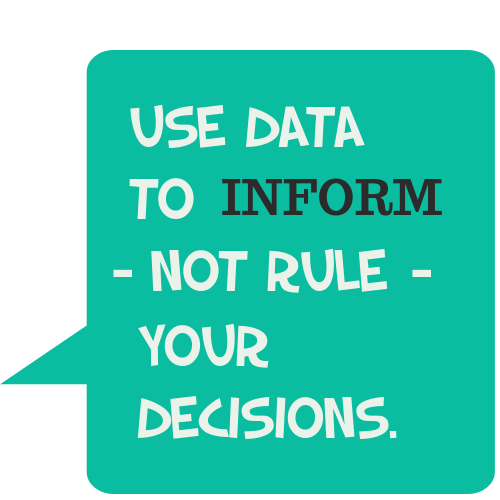
And that could very well sum up this post. Specific keywords and their associated search volume is good data to have. Yet ordering keywords in a list from high search volume to low and writing content for each is not a strategy. At best it's a tactic. A tactic that could have you running on a content treadmill instead of asking more questions, developing a creative strategy and taking bigger risks. Since this section already featured a quote, I’ll add another, with a reference to a great post to read next “ Barbells vs. Treadmills: A Fresh Take on Content Strategy” by Janessa Lantz.
"The quality of your content has an exponentially greater impact than the quantity."
— Janessa Lantz, Barbells vs. Treadmills: A Fresh Take on Content Strategy
Wrap up.
Keyword Research Won’t Solve Your Content Problem.
Going after single keywords based on search volume is a strategy only the big brands can achieve, and even they are having difficulties with that approach nowadays. Whether you work for a big brand or a local startup, SEOs need strategies and tools to handle the advancements of Google and create great content. To help our industry move on we have to share examples, knowledge of how search now works and have the right tools to deliver on a topic and intent SEO approach.
I'll be sharing examples of how me and the team at Greenlane do this in my webinar on Thursday, October 20th at 2pm EST - " SEO Keyword Research Matures to Topics and Intent." Hope to see you then!
Innovative SEO services
SEO is a patience game; no secret there. We`ll work with you to develop a Search strategy focused on producing increased traffic rankings in as early as 3-months.
A proven Allinclusive. SEO services for measuring, executing, and optimizing for Search Engine success. We say what we do and do what we say.
Our company as Semrush Agency Partner has designed a search engine optimization service that is both ethical and result-driven. We use the latest tools, strategies, and trends to help you move up in the search engines for the right keywords to get noticed by the right audience.
Today, you can schedule a Discovery call with us about your company needs.
Source:





![How to Find Low-Competition Keywords with Semrush [Super Easy]](https://new.allinclusive.agency/uploads/images/how-to-find-low-competition-keywords-with-semrush-super-easy.svg)